 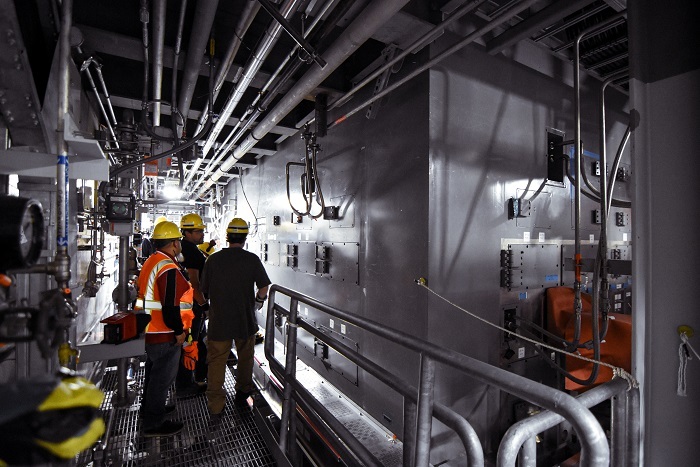 Workers with the Hanford Site’s Waste Treatment and Immobilization Plant inspect one of the plant’s large melters during its heatup process.
RICHLAND, Wash. — Crews at the Hanford Site’s Waste Treatment and Immobilization Plant (WTP) recently brought the second of two 300-ton melters up to the operating temperature of 2,100 degrees Fahrenheit as part of EM’s Direct-Feed Low-Activity Waste Program.
The achievement represents significant progress toward starting plant operations to immobilize in glass millions of gallons of radioactive and chemical waste from large underground tanks.
“Heating up the second melter is an important achievement for our Hanford team and represents another critical step in our journey to safe and efficient tank waste immobilization and disposal,” said Brian Vance, EM Office of River Protection and Richland Operations Office manager. “This success is the culmination of years of effort by our talented workforce, past and present, representing our commitment to advancing our cleanup mission and delivering taxpayer value.”
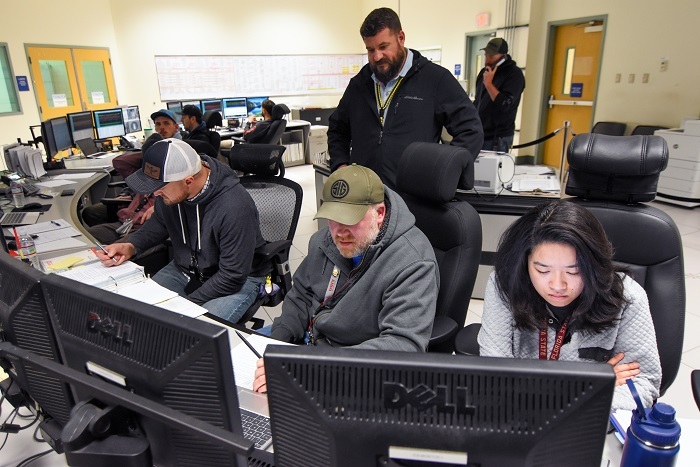 Staff at the Hanford Site’s Waste Treatment and Immobilization Plant are pictured inside the plant’s control room during heatup of the plant’s second of two melters.
WTP personnel began heating up the melter on March 12 by turning on 18 temporary startup heaters. The melter temperature was then gradually raised, reaching an operating temperature of 2,100 degrees on March 23. WTP personnel will allow the melter to stabilize at this temperature before small glass beads, known as frit, are loaded into the melter to establish a molten pool of glass.
Crews will then remove the startup heaters in the top of the melter and replace them with bubblers that circulate air in the molten glass and help maintain an even temperature.
EM Hanford contractor Bechtel National Inc. is commissioning the WTP.
"We are immensely proud of the heatup of Melter 2," said Brian Hartman, Bechtel senior vice president and project director for WTP. “This milestone reflects the dedication, expertise and collaborative spirit of our employees, contractors and partner, the Department of Energy. By incorporating the lessons learned from the first melter, we have reached this historic milestone safely and efficiently, underscoring our commitment to excellence and safety."
After running clean glass through the second melter, both melters and facility systems will go through several months of testing using simulated waste. Plant personnel will then run tests on the facility’s exhaust systems that remove contaminants.
When hot commissioning begins next year, tank waste treated to remove radioactive cesium and solids will be fed to the melters and mixed with the molten glass. That mixture will be poured into stainless steel containers to cool prior to transporting them the short distance to Hanford’s Integrated Disposal Facility.
Information on the WTP commissioning process is available on the Journey to Melter Heatup website. The plant facilities can be viewed using the self-guided Hanford Virtual Tour.
-Contributor: Tyler Oates
  DOE Chief of Staff Christopher Davis, left, presents the 2023 Federal Project Director of the Year Award to Portsmouth/Paducah Project Office Federal Project Director Jud Lilly for his leadership at the Portsmouth Site during the Department’s Project Management Workshop in Washington, D.C.
WASHINGTON, D.C. — Jud Lilly of the EM Portsmouth/Paducah Project Office (PPPO) received the 2023 Federal Project Director of the Year Award at DOE’s Project Management Workshop in Washington, D.C., last week.
“I am humbled and appreciative to be recognized as Federal Project Director of the Year,” said Lilly. “However, this award does not belong to one individual, as it represents more than one year of work. We have made great progress cleaning up the Portsmouth Site. I feel honored to be a part of this team and the success we have achieved.”
The annual award from the Energy Secretary recognizes individuals who demonstrate exceptional leadership and project management acumen.
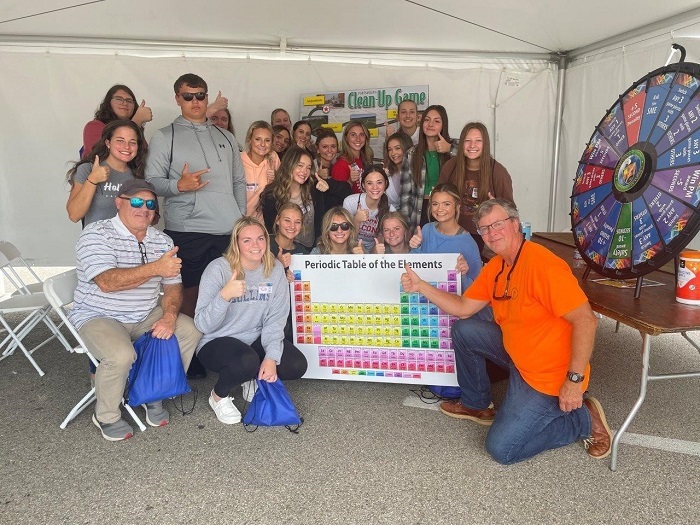 Portsmouth/Paducah Project Office Federal Project Director Jud Lilly, bottom right, congratulates the students who won the interactive DOE Site Cleanup Game during the 2023 Science Alliance.
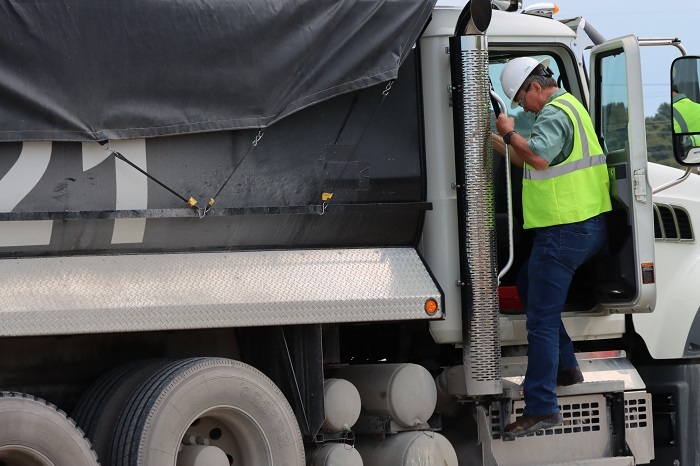 Portsmouth/Paducah Project Office Federal Project Director Jud Lilly climbs into a truck hauling the last load of debris from the X-326 Process Building demolition to the On-Site Waste Disposal Facility at the Portsmouth Site.
Over the past 18 years, Lilly has completed a portfolio of projects at the Portsmouth Site. These projects integrated decontamination and demolition (D&D) activities with the construction and operation of the On-Site Waste Disposal Facility (OSWDF) to dispose of D&D waste, all to advance the overall cleanup of the former uranium enrichment site.
“Jud’s tenacity and vast mission experience have fostered successes that were accomplished safely, below expected costs and ahead of schedule,” PPPO Manager Joel Bradburne said.
 EMTV: Watch this video about decontamination and demolition projects at EM’s Portsmouth Site. The video was played during DOE’s Project Management Workshop last week.
Among the projects led by Lilly include the successful demolition of the X-326 Process Building, the first of the former uranium enrichment process buildings at Portsmouth to come down, as well as current deactivation and future demolition work at the X-333 Process Building, another former enrichment process building.
The PPPO federal project director also oversaw projects to construct the OSWDF's first three disposal cells and initial infrastructure; the next three disposal cells and remaining infrastructure; and the remaining disposal cells and final cover system.
Lilly has led the Portsmouth X-326 Demolition Integrated Project Team since its inception in 2005. Prior to his arrival at Portsmouth, Lilly served as the EM point of contact and staff project engineer for D&D work at Oak Ridge, Tennessee.
Lilly stays involved in the community by engaging local students through DOE-sponsored events such as the annual Science Alliance and South Central Ohio Regional Science Bowl. He is dedicated to connecting with the area’s youth to inform them of career opportunities at the site, within the DOE complex and within the nuclear industry.
-Contributor: Michelle Teeters
 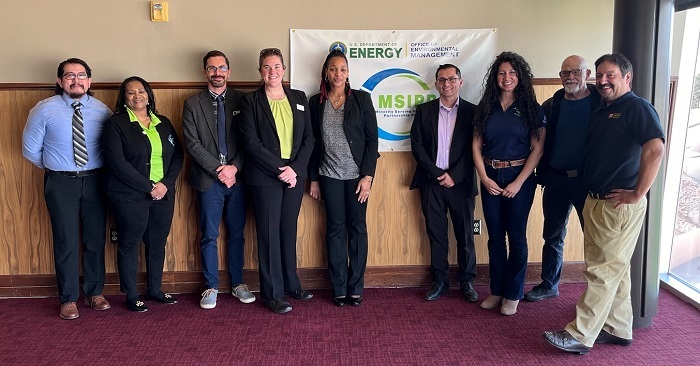 From left: Ricky Luna, University of Texas at El Paso (UTEP) Ph.D. student; Vivian Holloway, Savannah River National Laboratory Minority Serving Institutions Partnership Program (MSIPP) program manager; Skye Fortier, UTEP chemistry associate professor; Catherine Brewer, New Mexico State University (NMSU) chemical and materials engineering associate professor and project lead; Genia McKinley, EM MSIPP federal program manager; Sergio Martinez-Monteagudo, NMSU chemical and materials engineering associate professor; Regina Marquez, associate engineer at Savannah River Nuclear Solutions; Paul Andersen, NMSU chemical and materials engineering associate professor; and Frank Ramos, NMSU geological sciences professor.
LAS CRUCES, N.M. — In the Villanueva Victory Club, overlooking the New Mexico State University (NMSU) football field, a victory in academics, rather than sports, inspired celebration recently.
The reception commemorated the award of $24.7 million in grants by the EM Minority Serving Institutions Partnership Program (MSIPP). The EM MSIPP grants to seven minority serving institutions (MSI) across the country promote workforce development by providing funding for MSIs to develop new courses, purchase tools and equipment, and fund faculty, staff, and student development.
Of the seven awards, NMSU, in partnership with the University of Texas, El Paso, received more than $4.8 million for the NuChemE Pipeline program. Jay Gogue, NMSU interim president, described the core principles of the program as enhancing the “workforce’s capacity and diversity in managing radioactive tank waste. Through capacity building, interdisciplinary training and practical experiences, the project aims to bolster the skills necessary for this task.”
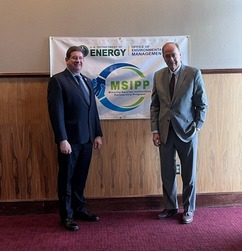 |
|
Greg Sosson, EM associate principal deputy assistant secretary for field operations, left, and Jay Gogue, New Mexico State University interim president. |
Greg Sosson, EM associate principal deputy assistant secretary for field operations, and EM staff members traveled to NMSU for the event.
“The people of EM have come together for the past 35 years, unified in our determination to address [DOE’s] environmental legacy, cleaning up sites and helping local tribes and communities prepare for the next chapter,” Sosson said in his remarks.
While EM’s mission is rooted in the legacy of the past, the cleanup program is focused on the future, Sosson noted.
“That is why our partnerships with schools like New Mexico State University are so important,” he said.
EM and supporting Savannah River National Laboratory participants toured many of the university’s laboratories and previewed research proposed under NMSU’s grant application. During the tour, students highlighted their proposed research projects and discussed science, technology, engineering and math (STEM) career opportunities in New Mexico related to environmental cleanup. They expressed their appreciation for the opportunity to pursue their passion for STEM while still being able to contribute to the communities they call home.
The EM MSIPP partnerships with MSIs, like NMSU, forge pathways for minority students to pursue potential careers with EM.
“The people of EM are its greatest asset, and the EM MSIPP grants are a remarkable investment in the workforce of the future,” Sosson added.
-Contributors: Emily Himmelfarb, Lauren Zack
 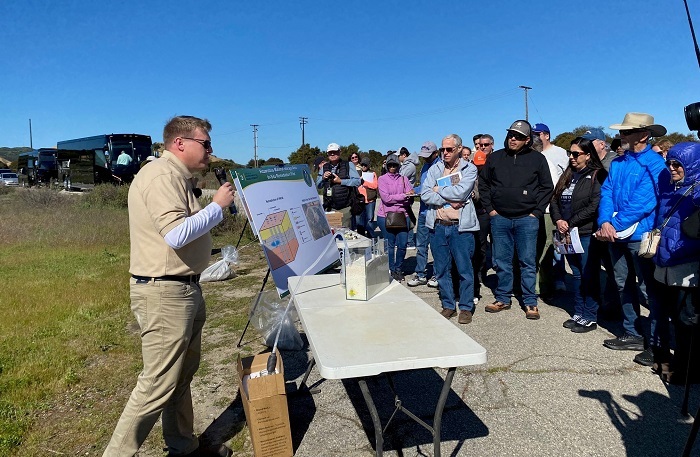 Josh Mengers, left, EM’s federal project director for the Energy Technology Engineering Center (ETEC), talks about the Hazardous Materials Storage Area and a pilot study for in-situ treatment for the contaminated groundwater in EM’s portion of the Santa Susana Field Laboratory, known as ETEC, during an April 6 site tour as part of Groundwater University.
SIMI VALLEY, Calif. — Community members gathered at the Santa Susana Field Laboratory (SSFL) on April 6 for a public site tour, the final event of the 2024 Groundwater University series.
The California Department of Toxic Substances Control (DTSC), in cooperation with the Boeing Company, NASA and DOE EM, hosted the education workshop series called Groundwater U. The goal of the workshops and tour was to educate stakeholders about groundwater at SSFL and prepare community members to review and comment on future groundwater decision documents from the laboratory.
SSFL is a 2,850-acre former rocket engine testing and energy research facility located in southeastern Ventura County. DOE conducted research and development, including leading-edge nuclear, solar and sodium reactor technology, on a 290-acre portion of the SSFL known as the Energy Technology Engineering Center (ETEC) in Area IV.
EM is charged with cleanup of residual contamination that remains in DOE’s portion of the ETEC site. The cleanup program completed demolition of buildings there in 2022 and is currently working with DTSC on final groundwater and soil cleanup plans.
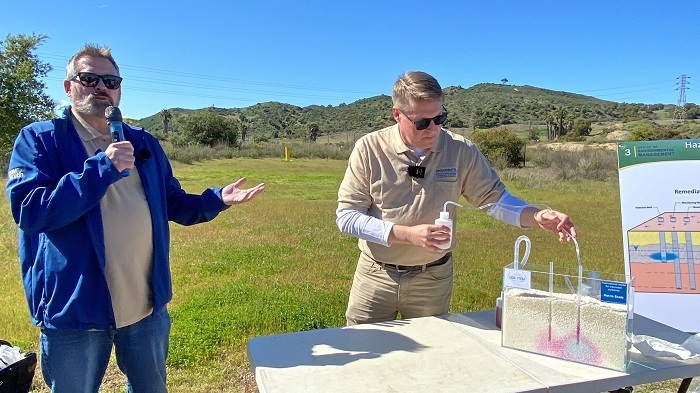 During the April 6 Groundwater University site tour at the Santa Susana Field Laboratory, Josh Mengers, right, EM’s federal project director for the Energy Technology Engineering Center, and Ryan Wymore of EM contractor CDM Smith show an educational model using rice and purple water, dyed from boiled cabbage leaves, to demonstrate the movement of contaminants in the groundwater and explain how in-situ treatment would work.
Research into the nature and extent of groundwater contamination at ETEC started in 1987. It involves analyzing groundwater from more than 600 wells, investigating the nature of the groundwater system through a series of aquifer tests, mapping of the geology of Simi Hills, and identifying and sampling seeps and springs.
During the Groundwater U site tour, Josh Mengers, EM’s federal project director for ETEC, and Ryan Wymore of EM contractor CDM Smith met with about 50 community members to discuss some of the new investigation techniques being used to collect data on the fractured bedrock and groundwater at Santa Susana.
Standing where the Hazardous Materials Storage Area used to be, the tour group talked about some of EM’s cleanup activities and groundwater interim measures, including the installation of a solar-powered automated pumping system and a pilot study on an in-situ biological and chemical oxidation treatment. Mengers showed an educational model using rice and purple water, dyed from boiled cabbage leaves, to demonstrate the movement of contaminants in the groundwater and explain how in-situ treatment would work.
Boeing and NASA also participated in the site tour, taking the community members to a handful of stops on each of their portions of SSFL to discuss groundwater and their treatment and pilot studies.
 |
|
Josh Mengers, right, EM’s federal project director for the Energy Technology Engineering Center (ETEC), answers questions from community members about rock core samples excavated from EM’s portion of the Santa Susana Field Laboratory, known as ETEC, during an April 6 site tour as part of Groundwater University. |
Groundwater U kicked off Jan. 23 with a community listening session focused on groundwater at SSFL. The session helped DTSC ensure the series content was tailored to community interests.
Matt Becker, a professor and Conrey Endowed chair of hydrogeology in the Earth Science Department at California State University, Long Beach, presented an overview of groundwater and hydrogeology, including what groundwater is and how it moves, during the first session on Feb. 20.
The second session on March 12 built on the first workshop, with Beth Parker and John Cherry discussing where groundwater contamination is at SSFL, a geologic formation called the Chatsworth formation and the transport of contaminants. More than 100 people attended the workshop to listen to the presentation and ask questions of DTSC, Boeing, and Parker and Cherry, who are professors at the University of Guelph in Canada and part of the SSFL groundwater advisory panels.
At the final workshop on April 4, representatives from DTSC, EM, NASA and Boeing discussed groundwater treatment options studied at SSFL, as well as groundwater interim measures, and pilot tests and treatability studies. More than 60 people attended the third workshop.
More information about Groundwater U, including recordings of past sessions and materials, can be found at DTSC’s SSFL webpage. And click here for information about EM’s work at Santa Susana.
-Contributor: Melissa Simon
 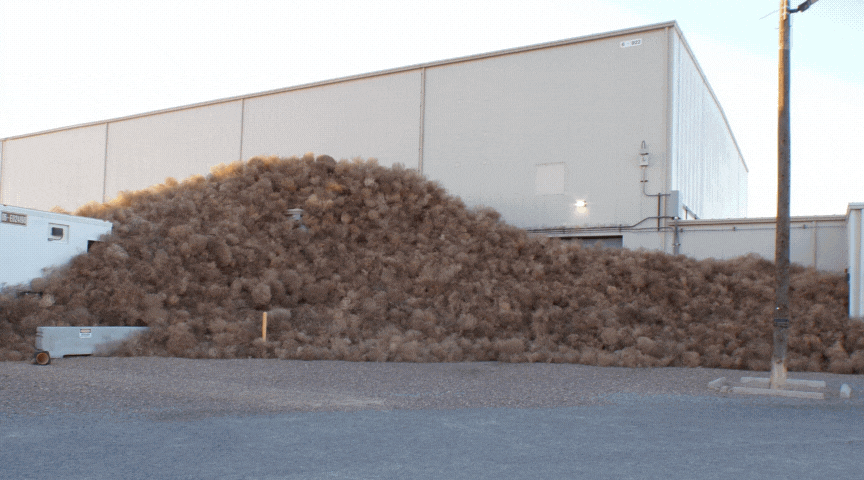
LAS VEGAS — One of the unique challenges the EM Nevada Program faces was on display at the Nevada National Security Site (NNSS) in early March when strong winds caused a “tumbleweed takeover” on the site. Wind gusts approaching 70 miles per hour prompted a tumbleweed invasion on property surrounding several buildings at the NNSS, including one used by the EM Nevada Program. The scenes throughout the site were startling as hungry tumbleweed clusters consumed roadsides, fences and other structures. In some instances, tumbleweed stacked as high as trailers, making access impossible. Crews at the site soon cleared out the accumulation and work resumed. Photos courtesy of Mission Support and Test Services.

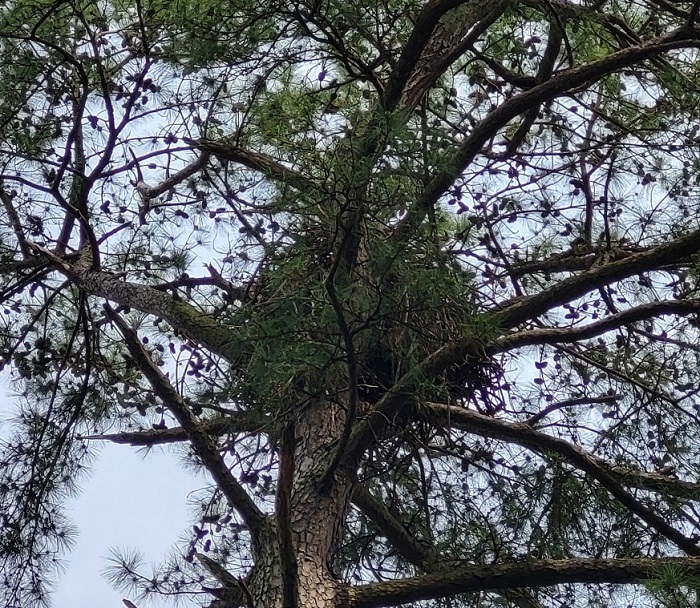 A newly established bald eagle nest in a treetop alongside a lake on Savannah River Site. Photo courtesy of the U.S. Department of Agriculture.
AIKEN, S.C. — While conducting aerial surveys over bald eagle nesting areas on Savannah River Site (SRS), a U.S. Forest Service wildlife biologist found a special surprise: an active bald eagle nest along the edge of one of the site’s lakes.
This brings the site’s number of known active nests for bald eagles to two. Two breeding pairs of eagles reside on the site.
While those figures may seem small, the implications of what they mean is much larger. Eagles don’t reach breeding maturity until 4 to 6 years of age. That likely means these birds of prey have been present in the area for some time. The last known active nest in that area was in 2011.
“While we don’t expressly manage the natural resources for bald eagles, the fact that we have a growing population of an endangered species is a good indicator of the successful forest management practices in place here on Savannah River Site,” Savannah River Wildlife Program Manager Thomas Mims said.
As part of its wildlife management program on the SRS, the Forest Service conducts annual wildlife surveys for different species throughout the year. Past surveys for bald eagles found just one nest with an average of eight to 15 documented sightings across the site.
Visit the U.S. Fish and Wildlife Service webpage to learn more about bald eagles. For more about the Forest Service wildlife management program on SRS, contact Mims at thomas.mims@usda.gov. To learn more about the mission of the U.S. Forest Service on SRS, contact Joe Orosz, public affairs specialist, at josef.orosz@usda.gov.
-Contributor: Joe Orosz
 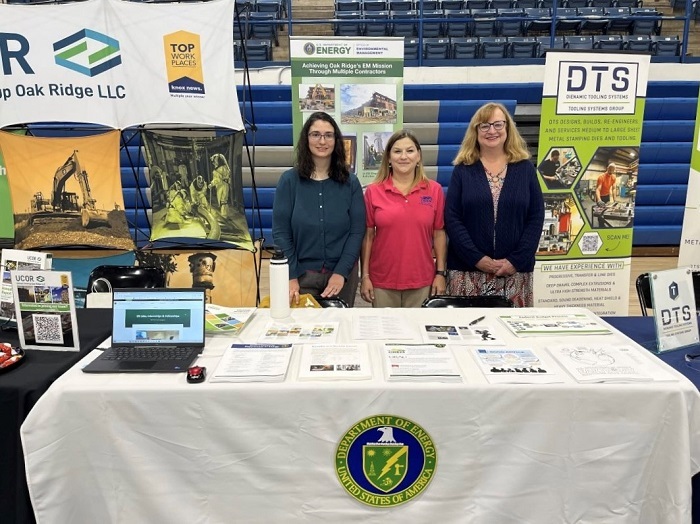 From left, Oak Ridge Office of Environmental Management employees Laura Hedrick, Staci Monroe with support contractor Navarro and Elizabeth Phillips set up a booth to converse with students at the Roane County school system’s career day.
OAK RIDGE, Tenn. – More than 1,000 students gathered last week for a local school system’s annual career day, joining the Oak Ridge Office of Environmental Management (OREM) and nearly 60 other companies and organizations from across the region.
The middle and high school students connected with employees from federal and state governments, universities, trades groups, and medical and health companies. They learned about various careers and the educational requirements needed for them.
The career day event was held by the Roane County School District. DOE’s Oak Ridge Reservation is located within Roane and Anderson counties in eastern Tennessee.
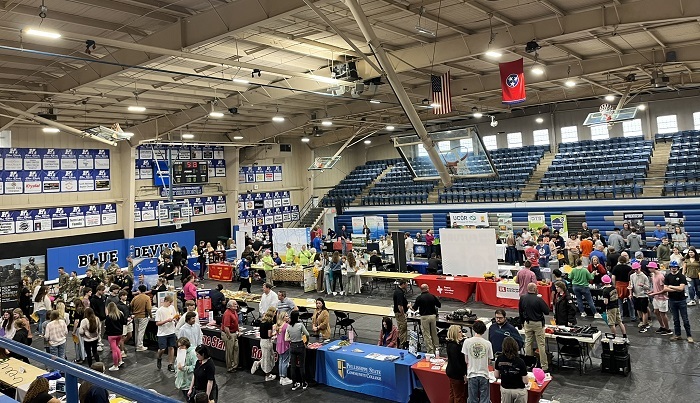 More than 1,000 middle school and high school students gathered for the Roane County school system’s annual career day. Nearly 60 companies and organizations from across the region participated in the event, including the Oak Ridge Office of Environmental Management.
Among the employees in attendance was OREM project manager Laura Hedrick, who shared insight about her journey supporting the cleanup mission.
“I first learned about OREM after finishing my master’s degree,” said Hedrick. “I was looking for different opportunities related to helping the environment.”
With degrees in general science, French and education, and environmental management and policy, Hedrick began her career search.
She found her ideal match through the Oak Ridge Institute for Science and Education and Oak Ridge Associated Universities Science Education and Internship Program. The program provided a fellowship at OREM, where Hedrick gained experience supporting projects at the Y-12 National Security Complex. After serving in that role for two years, she joined the OREM team permanently in a federal position.
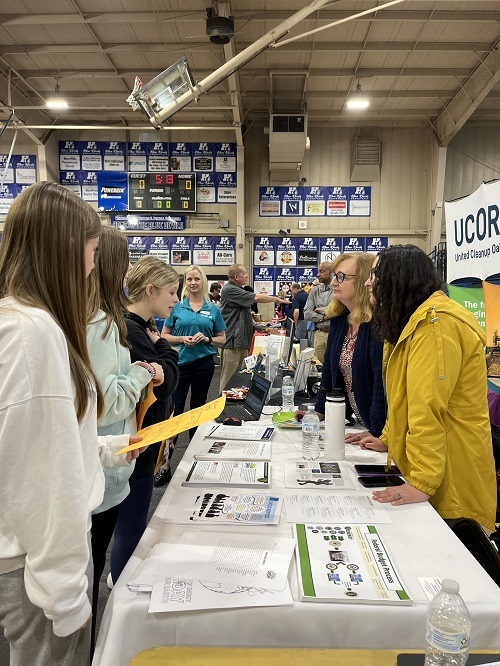 |
|
Oak Ridge Office of Environmental Management (OREM) Project Manager Laura Hedrick, at right, talks with high school students about OREM’s mission and careers. |
With several years of experience, Hedrick is now the one helping others find careers that fit their interests and skills. She shared a positive message with the many students at the event.
“I tell those who are interested that OREM is a great place to work, where you always have the opportunity to learn more, make great connections, help people and help the environment,” she said.
Hedrick also discussed how she enjoys supporting the EM mission in Oak Ridge. In her current role, Hedrick oversees several deactivation and demolition projects that are helping transform the Oak Ridge National Laboratory.
“I’m part of a team that’s working together to make a positive difference in our area by helping to clean up the environment,” she said. “Having grown up in the area, the idea of being able to help with that is very rewarding.”
-Contributor: Ben Williams
 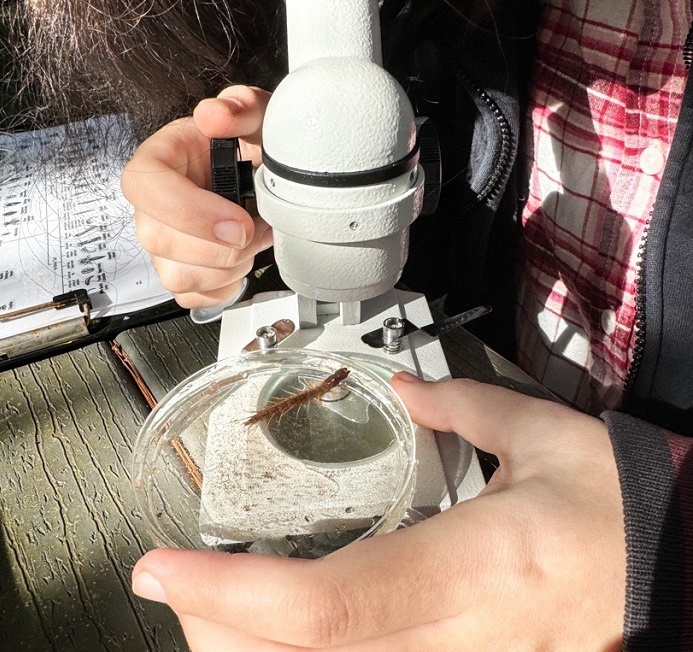 A local high school student peers under a microscope at a macroinvertebrate as part of a field excursion hosted at the University of Georgia’s Savannah River Ecology Laboratory Conference Center job shadowing day inspired to give high school juniors and seniors a taste of what wildlife ecologists and field technicians do.
AIKEN, S.C. — The University of Georgia’s Savannah River Ecology Laboratory (SREL) recently participated in a county-wide job shadow day, giving high school juniors and seniors a glimpse into available science, technology, engineering and math (STEM) roles on Savannah River Site once they graduate.
Under guidance of the SREL Outreach team, the students engaged in various hands-on activities to gain insight into careers such as ecologist and field technician.
"I was delighted that SREL provided the opportunity for my students to see what the job of a wildlife biologist entails,” says Kacee Poppy, local chemistry teacher from South Aiken High School and lead organizer for the SREL excursion. “This experience was truly eye-opening for my students because many of them thought a biologist just walked around in the woods all day and got to play with animals. However, as a result of this field trip, they now understand how much work goes into collecting data about various types of creatures by utilizing specialized trapping techniques.”
During the event, the students learned about local flora and fauna, identified organisms, watched trail camera videos, looked through microscopes, conducted water sampling and safely interacted with animals captured in the field.
The students left the event with a newfound appreciation for nature, and a heightened sense of curiosity and excitement for the world of ecology.
“Afterwards, several students told me the trip solidified their interest in the field and they were inspired and excited to pursue becoming a wildlife biologist," Poppy said.
Geared to inspire and impact the next generation STEM workforce, the job shadow day was one of many opportunities SREL offers the community, especially students, throughout the year.
-Contributors: Katrina M. Ford, Lauren Maynor
|